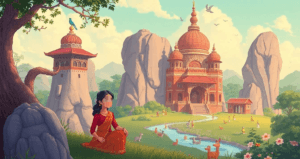Ghibli AI Art Craze: 5 Stunning Indian Art Styles You Must See!
The recent surge of Ghibli-style AI art on social media has captivated users worldwide, transforming personal photos into dreamy, hand-painted visuals. Inspired by Studio Ghibli’s legendary storytelling and artistic brilliance, this trend has sparked debates among artists about the value of traditional craftsmanship versus AI-generated content. While some appreciate AI’s ability to speed up creative processes, others argue that it lacks the soul and originality of human-made art. Indian artists express mixed feelings—some worry about copyright concerns and the loss of artistic integrity, while others acknowledge AI’s role in increasing public interest in art.
However, beyond the AI trend, India boasts rich artistic traditions like Madhubani, Kalamkari, and Raja Ravi Varma’s iconic paintings, which have stood the test of time. These styles, deeply rooted in cultural heritage, continue to thrive in modern fashion, home décor, and digital art. Unlike AI-generated pieces, these traditional forms carry stories, emotions, and the distinct touch of the artist. As AI reshapes creativity, embracing and supporting timeless Indian art forms ensures their legacy remains alive for future generations.

Ghibli AI Art Craze: 5 Stunning Indian Art Styles You Must See!
Social media is buzzing with dreamy, AI-generated “Ghibli-style” art, turning ordinary photos into whimsical anime scenes. But while this trend is fun, it has sparked a bigger conversation about art, creativity, and the irreplaceable value of human touch. Let’s dive into the story behind Ghibli and explore why India’s own artistic treasures deserve the spotlight, too.
What’s the Ghibli Hype About?
Studio Ghibli, a legendary Japanese animation studio, was founded in 1985 by Hayao Miyazaki and his peers. Known for films like Spirited Away and My Neighbor Totoro, Ghibli’s magic lies in its hand-painted visuals, emotional storytelling, and themes of nature and resilience. The studio’s name, inspired by a desert wind, reflects its mission to blow fresh ideas into animation.
Recently, AI tools like ChatGPT have allowed users to instantly transform photos into Ghibli-esque art. While this technology is exciting, many artists worry it undermines years of craftsmanship. Can a machine truly capture the soul of art?
Indian Artists Weigh In: AI vs. Human Creativity
While AI-generated art is popular, Indian creators highlight its limitations. A seasoned game designer (name changed) shared, “AI speeds up concept creation, but it’s just remixing existing work. Where’s the originality or credit to true artists?” Others, like Chennai-based Muralidharan Alagar, acknowledge that AI has boosted interest in art but stress that “real art comes from effort and emotion—something AI can’t replicate.”
Puducherry artist Rajkumar Sthabathy adds, “A painting carries the artist’s heart. Can a machine mimic that?” Mumbai watercolorist Vikrant Shitole agrees: “AI lacks the human connection. Art is about storytelling, not algorithms.”
India’s Timeless Art Forms: Beyond Digital Trends
While AI dominates social media, India’s rich artistic heritage offers styles that have inspired generations. Here are four stunning examples:
1. Madhubani Paintings: Stories on Walls
- Origins: Born in Bihar and Nepal over 1,300 years ago, Madhubani art was traditionally painted by women on home walls during festivals.
- Style: Bold lines, vibrant natural dyes, and intricate patterns depict myths, nature, and daily life.
- Today: From sarees to smartphone cases, Madhubani thrives in modern designs while staying rooted in tradition.
2. Amar Chitra Katha: Mythology Meets Art
- Origins: Launched in 1967 by Anant Pai, these comics simplified India’s epic tales for young readers.
- Style: Vibrant, detailed panels reminiscent of Ghibli’s storytelling charm.
- Today: Still beloved, the series bridges generations through print and digital editions.
3. Kalamkari: The Art of the Pen
- Origins: With 3,000 years of history, Andhra Pradesh’s Kalamkari (“pen work”) began as temple storytelling on fabric.
- Style: Hand-painted or block-printed textiles featuring gods, nature, and folklore in earthy dyes.
- Today: A fashion favorite, Kalamkari’s elegance shines in sarees, dupattas, and home décor.
4. Raja Ravi Varma: Blending East and West
- Origins: This 19th-century Kerala artist fused European realism with Indian themes, creating iconic portraits of deities and royalty.
- Style: Graceful, lifelike depictions of South Indian women and mythological scenes.
- Today: His art adorns calendars, posters, and religious spaces, celebrated for its timeless beauty.
Why Traditional Art Matters in the AI Age
AI might create pretty pictures, but it can’t replace the stories, history, and heart poured into every brushstroke of traditional art. These Indian styles aren’t just techniques—they’re cultural legacies passed down through centuries.
So, the next time you see a Ghibli-style AI filter, take a moment to explore India’s own artistic wonders. Support local artisans, share their work, and keep these traditions alive. After all, true art isn’t about trends—it’s about connection, and that’s something no machine can replicate.
You must be logged in to post a comment.